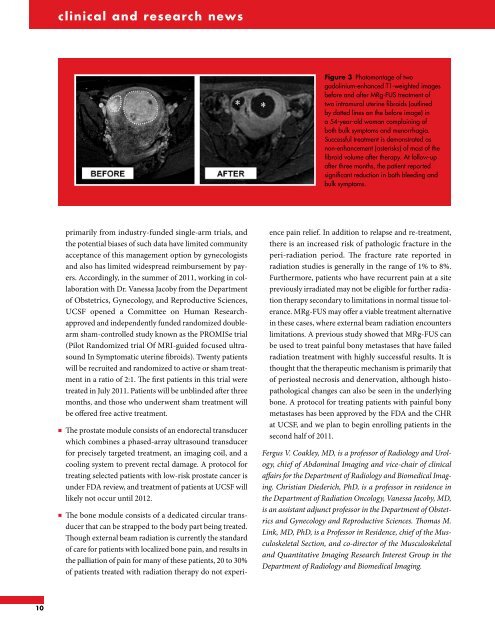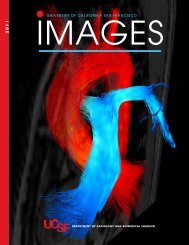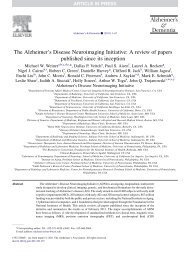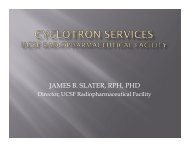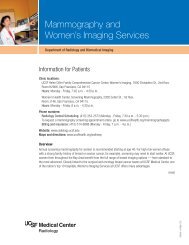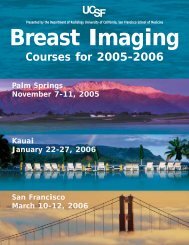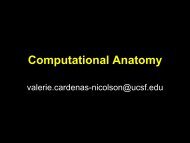Images - Department of Radiology & Biomedical Imaging ...
Images - Department of Radiology & Biomedical Imaging ...
Images - Department of Radiology & Biomedical Imaging ...
Create successful ePaper yourself
Turn your PDF publications into a flip-book with our unique Google optimized e-Paper software.
10<br />
clinical and research news<br />
primarily from industry-funded single-arm trials, and<br />
the potential biases <strong>of</strong> such data have limited community<br />
acceptance <strong>of</strong> this management option by gynecologists<br />
and also has limited widespread reimbursement by payers.<br />
Accordingly, in the summer <strong>of</strong> 2011, working in collaboration<br />
with Dr. Vanessa Jacoby from the <strong>Department</strong><br />
<strong>of</strong> Obstetrics, Gynecology, and Reproductive Sciences,<br />
UCSF opened a Committee on Human Researchapproved<br />
and independently funded randomized doublearm<br />
sham-controlled study known as the PROMISe trial<br />
(Pilot Randomized trial Of MRI-guided focused ultrasound<br />
In Symptomatic uterine fibroids). Twenty patients<br />
will be recruited and randomized to active or sham treatment<br />
in a ratio <strong>of</strong> 2:1. The first patients in this trial were<br />
treated in July 2011. Patients will be unblinded after three<br />
months, and those who underwent sham treatment will<br />
be <strong>of</strong>fered free active treatment.<br />
n The prostate module consists <strong>of</strong> an endorectal transducer<br />
which combines a phased-array ultrasound transducer<br />
for precisely targeted treatment, an imaging coil, and a<br />
cooling system to prevent rectal damage. A protocol for<br />
treating selected patients with low-risk prostate cancer is<br />
under FDA review, and treatment <strong>of</strong> patients at UCSF will<br />
likely not occur until 2012.<br />
n The bone module consists <strong>of</strong> a dedicated circular transducer<br />
that can be strapped to the body part being treated.<br />
Though external beam radiation is currently the standard<br />
<strong>of</strong> care for patients with localized bone pain, and results in<br />
the palliation <strong>of</strong> pain for many <strong>of</strong> these patients, 20 to 30%<br />
<strong>of</strong> patients treated with radiation therapy do not experi-<br />
Figure 3 Photomontage <strong>of</strong> two<br />
gadolinium-enhanced T1-weighted images<br />
before and after MRg-FUS treatment <strong>of</strong><br />
two intramural uterine fibroids (outlined<br />
by dotted lines on the before image) in<br />
a 54-year-old woman complaining <strong>of</strong><br />
both bulk symptoms and menorrhagia.<br />
Successful treatment is demonstrated as<br />
non-enhancement (asterisks) <strong>of</strong> most <strong>of</strong> the<br />
fibroid volume after therapy. At follow-up<br />
after three months, the patient reported<br />
significant reduction in both bleeding and<br />
bulk symptoms.<br />
ence pain relief. In addition to relapse and re-treatment,<br />
there is an increased risk <strong>of</strong> pathologic fracture in the<br />
peri-radiation period. The fracture rate reported in<br />
radiation studies is generally in the range <strong>of</strong> 1% to 8%.<br />
Furthermore, patients who have recurrent pain at a site<br />
previously irradiated may not be eligible for further radiation<br />
therapy secondary to limitations in normal tissue tolerance.<br />
MRg-FUS may <strong>of</strong>fer a viable treatment alternative<br />
in these cases, where external beam radiation encounters<br />
limitations. A previous study showed that MRg-FUS can<br />
be used to treat painful bony metastases that have failed<br />
radiation treatment with highly successful results. It is<br />
thought that the therapeutic mechanism is primarily that<br />
<strong>of</strong> periosteal necrosis and denervation, although histopathological<br />
changes can also be seen in the underlying<br />
bone. A protocol for treating patients with painful bony<br />
metastases has been approved by the FDA and the CHR<br />
at UCSF, and we plan to begin enrolling patients in the<br />
second half <strong>of</strong> 2011.<br />
Fergus V. Coakley, MD, is a pr<strong>of</strong>essor <strong>of</strong> <strong>Radiology</strong> and Urology,<br />
chief <strong>of</strong> Abdominal <strong>Imaging</strong> and vice-chair <strong>of</strong> clinical<br />
affairs for the <strong>Department</strong> <strong>of</strong> <strong>Radiology</strong> and <strong>Biomedical</strong> <strong>Imaging</strong>.<br />
Christian Diederich, PhD, is a pr<strong>of</strong>essor in residence in<br />
the <strong>Department</strong> <strong>of</strong> Radiation Oncology, Vanessa Jacoby, MD,<br />
is an assistant adjunct pr<strong>of</strong>essor in the <strong>Department</strong> <strong>of</strong> Obstetrics<br />
and Gynecology and Reproductive Sciences. Thomas M.<br />
Link, MD, PhD, is a Pr<strong>of</strong>essor in Residence, chief <strong>of</strong> the Musculoskeletal<br />
Section, and co-director <strong>of</strong> the Musculoskeletal<br />
and Quantitative <strong>Imaging</strong> Research Interest Group in the<br />
<strong>Department</strong> <strong>of</strong> <strong>Radiology</strong> and <strong>Biomedical</strong> <strong>Imaging</strong>.


